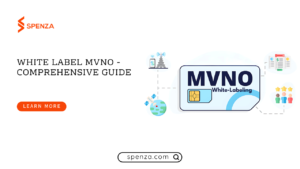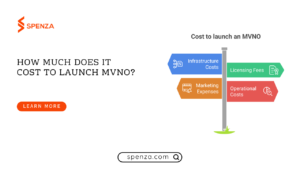The telecom landscape is evolving, and Mobile Virtual Network Operators (MVNOs) have emerged as major players in providing flexible and affordable mobile connectivity solutions. But have you ever wondered how these operators function without owning their cell towers or antennas?
The answer lies in a crucial industry dynamic: Mobile Network Operators (MNOs), known as traditional carriers, own the physical infrastructure—such as base stations, antennas, and spectrum licenses. Apart from running their own retail business, MNOs lease out network access to MVNOs.
This arrangement isn’t just a business strategy for extra revenue; in many countries, it’s a legal requirement to promote competition and ensure affordable mobile services. As a result, MVNOs don’t own any Radio Access Network (RAN) infrastructure—instead, they rely on roaming agreements with MNOs to deliver services to customers.
However, not all MVNOs operate the same way. Some MVNOs act as simple resellers of mobile services, while others take on a more advanced role by managing their network technology stack, customer relationships, and pricing models. These advanced operators are known as Full MVNOs.
So, what exactly is a Full MVNO, and how does it compare to other MVNO types? More importantly, what are the benefits and challenges of choosing this model? Let’s dive in
What is a Full MVNO?
A Full MVNO is much more than just a reseller of mobile services—it operates as an independent mobile provider, controlling almost every aspect of the business except for the radio network infrastructure. Unlike smaller MVNOs that simply rebrand and resell an MNO’s services, Full MVNOs have their own core network, giving them unparalleled flexibility and control over their offerings.
Here’s what sets a Full MVNO apart:
1. Own SIM Card Issuance
A key differentiator of Full MVNOs is that they issue their own SIM cards instead of relying on an MNO’s pre-configured ones. This allows them to:
- Customize SIM profiles and enable multi-network connectivity.
- Offer eSIM technology for seamless activations and remote provisioning.
- Implement advanced security features, ensuring better fraud protection.
- Control roaming agreements independently, providing more competitive global connectivity options.
2. Independent Billing and Customer Support
Unlike other MVNO types that depend on MNOs for billing, a Full MVNO has full control over pricing, invoicing, and customer support. This independence allows for:
- Custom pricing models (e.g., pay-as-you-go, bundled data plans, enterprise-grade solutions).
- More flexible billing structures, including subscription-based and usage-based plans.
- Direct management of customer relationships, ensuring a better experience and personalized support.
3. Ability to Define Mobile Plans and Pricing
Full MVNOs aren’t restricted to pre-set packages from an MNO. They have the flexibility to:
- Design their own data, voice, and messaging plans to suit different customer segments (e.g., IoT, enterprise, consumer).
- Offer targeted promotions, discounts, and loyalty programs.
- Bundle services with value-added features, such as VPNs, cloud storage, or premium content subscriptions.
4. Full Control Over Network Switching and Subscriber Management
Because Full MVNOs operate their own core network, they have complete control over:
- Managing subscriber data and authentication.
- Implementing advanced Quality of Service (QoS) controls for enhanced performance.
- Seamlessly switching between multiple MNOs for better coverage and reliability.
This autonomy allows them to optimize network partnerships and ensure customers always receive the best possible service, whether through multi-network connectivity or real-time traffic management.
Why Choose the Full MVNO Model?
Opting for a Full MVNO model gives businesses significant advantages over other MVNO types:
- Greater Control
Full MVNOs have complete control over customer relationships, branding, and service offerings, rather than reselling an existing MNO’s services. - Better Profit Margins
Since Full MVNOs manage their billing and pricing structures, they can optimize revenue streams instead of relying on wholesale pricing from an MNO. - Enhanced Customer Experience
Full MVNOs can customize services, introduce loyalty programs, and offer tailored plans to specific customer segments. - Scalability & Expansion
With their own core infrastructure, Full MVNOs can expand into new markets or introduce additional mobile services without being tied to a single network provider. - Brand Differentiation
Unlike reseller MVNOs, which sell a standardized mobile service, Full MVNOs can innovate by offering features such as multi-network roaming, eSIM support, and specialized business plans.
However, running a Full MVNO also comes with its own set of challenges, which we’ll explore further.
Comparing Full MVNOs with Other MVNO Types
Understanding the difference between Full MVNOs and other MVNO types is crucial when determining the right approach. Here’s a breakdown of the key differences:
MVNO Types and Their Characteristics
| Feature | Reseller MVNO | Service Provider MVNO | Enhanced Service Provider MVNO | Full MVNO |
| Network Ownership | No | No | No | No (Relies on MNO infrastructure) |
| SIM Card Control | No | No | Sometimes | Yes |
| Billing & Pricing | Set by MNO | Managed by MVNO | Managed by MVNO | Fully controlled by MVNO |
| Customer Support | Limited | Managed by MVNO | Managed by MVNO | Fully controlled by MVNO |
| Value-Added Services | None | Limited | Advanced (e.g., apps, content) | Full customization possible |
| Branding | MNO’s brand | MVNO’s brand | MVNO’s brand | Fully white-labeled |
| Infrastructure Ownership | No | No | No | Owns core infrastructure |
| Ideal For | Budget-focused operators | Businesses seeking moderate control | Operators providing enhanced services | Businesses looking for full autonomy |
While reseller and service provider MVNOs operate with minimal infrastructure investment, Full MVNOs require significant setup costs but offer long-term growth opportunities and competitive differentiation.
Key Benefits of Full MVNOs
- Complete Control Over Branding and Customer Experience
Unlike reseller MVNOs that operate under an MNO’s brand, Full MVNOs have complete control over their brand, allowing them to create unique customer experiences and build stronger relationships. - Higher Profit Margins and Flexible Pricing
Since Full MVNOs manage their own billing and pricing, they have the flexibility to offer competitive pricing models, bundle services, and introduce dynamic pricing strategies based on customer behavior. - Network Agility and Multi-Carrier Support
Many Full MVNOs operate across multiple MNOs, ensuring stronger coverage and better quality for their customers. With eSIM technology, Full MVNOs can dynamically switch networks to provide the best possible connectivity. - Ability to Introduce Innovative Services
From IoT connectivity and enterprise solutions to custom mobile plans for niche markets, Full MVNOs can differentiate themselves by offering specialized services. - Scalability for Future Growth
Since they own their core infrastructure, Full MVNOs can easily scale by expanding into new regions, adding new service offerings, or integrating emerging technologies like 5G.
Challenges of Operating as a Full MVNO
While the benefits are significant, there are also key challenges to consider:
- Higher Upfront Costs
Unlike reseller MVNOs, Full MVNOs require investment in core network components, billing systems, SIM management, and customer support operations. - Regulatory Compliance
Full MVNOs must comply with telecom regulations in different countries, including SIM registration rules, number portability, and network security requirements. - Managing Network Agreements
Negotiating agreements with MNOs for network access can be complex, requiring strong partnerships and favorable pricing structures to remain competitive. - Technical Complexity
Running a Full MVNO involves managing SIM card provisioning, billing platforms, and service activation, which requires expertise in telecom operations. - Customer Acquisition & Retention
Since Full MVNOs operate independently, they must invest heavily in marketing, sales, and customer retention strategies to build a strong subscriber base.
Is Becoming a Full MVNO Right for Your Business?
The decision to launch a Full MVNO depends on multiple factors:
- Do you want complete control over your brand, pricing, and services?
- Can you invest in the required infrastructure and operational capabilities?
- Are you targeting a niche market that requires customization beyond what traditional MNOs offer?
- Do you have the technical and regulatory expertise to manage your own mobile services?
If the answer is yes, then a Full MVNO could be the right path for you. However, for businesses looking for a faster and less complex entry into the market, Service Provider or Enhanced Service Provider MVNO models may be a better starting point.
How Spenza Helps Full MVNOs Succeed
Spenza provides an advanced MVNO enablement platform that simplifies the process of launching and managing Full MVNO operations. With Spenza, businesses can:
- Seamlessly integrate with MNO networks for reliable connectivity
- Manage SIM provisioning, billing, and customer data in one place
- Offer eSIM-enabled services with global coverage
- Leverage automated cost-control features to optimize expenses
- Scale operations effortlessly with cloud-based infrastructure
With Spenza’s white-label MVNO solutions, businesses can focus on growth, innovation, and customer satisfaction—without the complexities of building an MVNO from scratch.
Conclusion
Becoming a Full MVNO offers businesses the ultimate control over their mobile services, branding, and customer relationships. However, it requires significant investment, regulatory expertise, and technical capabilities.
FAQs
A Full MVNO owns its core infrastructure, manages SIM cards, and controls billing, whereas a Service Provider MVNO resells network services with limited customization.
Full MVNOs earn revenue through customized mobile plans, value-added services, business partnerships, and IoT connectivity solutions.
Yes! Many Full MVNOs offer eSIM services, allowing users to switch networks without physical SIM cards.
Timelines vary based on regulatory approvals and technical setup, but platforms like Spenza can help accelerate the process.
Businesses should evaluate infrastructure costs, regulatory requirements, MNO partnerships, and market demand before launching.
By leveraging a white-label MVNO platform like Spenza, businesses can fast-track their Full MVNO journey with the right tools, infrastructure, and support.
Thinking of launching a Full MVNO? Contact Spenza today to explore how our platform can accelerate your success.



